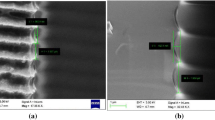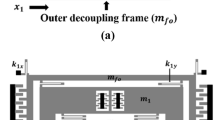Abstract
Fabrication of high aspect ratio microelectromechanical systems (MEMS) like comb drive structures are mostly done by DRIE (Deep Reactive Ion Etching) process. Bosch process is a type of DRIE which involves alternate repetition of plasma etching and side wall passivation to achieve deep vertical structures. A continued plasma etching may lead to tapered wall due to some lateral etching. Although, a straight and smooth wall is expected due to combined alternate processes of etching and passivation, very often the resulting walls are having surface undulations called as scalloping. So, due to slanting, scalloping and combined slanting and scalloping defects the working and performance of a MEMS device get affected. MEMS gyrocope is one such widely comercialized device, which is required to measure angular rotation wth certain accuracy. We take a simple single-axis MEMS vibratory gyroscope to study the effect on these defects on its dynamics performance. The study presented in the paper may be useful for including undesirable effects in designing MEMS vibratory gyroscopes.






















Similar content being viewed by others
References
Acar C, Schofield AR, Trusov AA, Costlow LE, Shkel AM (2009) Environmentally robust MEMS vibratory gyroscopes for automotive applications. IEEE Sens J 9(12):1895–1906. https://doi.org/10.1109/JMEMS.2002.1007405
Ashok A, Kumar PM, Pal P, Pandey AK (2018) An idea of oscillating alphabets through mechanical coupling. ISSS J Micro Smart Syst 7(2):145–150
Ashok A, Manoj Kumar P, Singh SS, Raju P, Pal P, Pandey AK (2018) Achieving wideband micromechanical system using coupled non-uniform beams array. Sens Actuators A Phys 273:12–18
Bao M-H (2000) Micro mechanical transducers: pressure sensors, accelerometers and gyroscopes. Elsevier, Amsterdam
Bertini S, Matteo V, Alvise B, Pierliugi B, Giuseppe R, Nicola PB (2018) Scalloping and stress concentration in DRIE-manufactured comb-drives. In: Actuators, vol 7, no 3, p 57. Multidisciplinary Digital Publishing Institute
Cenk A, Shkel A (2008) MEMS vibratory gyroscopes: structural approaches to improve robustness. Springer, New York
Chen K-S, Ayon AA, Zhang X, Spearing SM (2002) Effect of process parameters on the surface morphology and mechanical performance of silicon structures after deep reactive ion etching (DRIE). J Microelectromech Syst 11(3):264–275. https://doi.org/10.1109/JMEMS.2002.1007405
Cheng Zhiqiang, Ding Yingtao, Xiao Lei, Wang Xinghua, Chen Zhiming (2019) Comparative evaluations on scallop-induced electric-thermo-mechanical reliability of through-silicon-vias. Microelectron Reliab 103:113512
Dean J, Robert N, Antonio L (2009) Applications of microelectromechanical systems in industrial processes and services. IEEE Trans Ind Electron 56(4): 913–925
Dong H, Xingguo X (2009) Design and analysis of a MEMS comb vibratory gyroscope. In: UB-NE ASEE 2009 conference
Fedder GK (1994) Simulation of microelectromechanical systems. PhD diss., University of California, Berkeley
Gangele A, Akarapu A, Sharma CS, Pal P, Pandey AK (2019) Frequency analysis of hexagonal microbeam with 2D nanofiber mat. IOP Mater Res Express 6(8):085631 (1-10)
Gao Lili, Zhou Zai-Fa, Huang Qing-An (2017) Modeling of the effect of process variations on a micromachined doubly-clamped beam. Micromachines 8(3):81
Ghasemzade SV, Jamshidi F (2018) Applications of inertial navigation systems in medical engineering. J Biomed Phys Eng 8(3):325
Jete AH, Lefevre HC (1981) Sagnac effect in fiber gyroscopes. Opt Lett 6(8):401–403
Laermer F, Sami F, Lauri S, Kai K (2015) Deep reactive ion etching. In Handbook of silicon based MEMS materials and technologies, pp 444–469. William Andrew Publishing
Li J, Liu AQ, Zhang QX (2006) Tolerance analysis for comb-drive actuator using DRIE fabrication. Sens Actuators A Phys 125(2):494–503
Manoj Kumar P, Ashok A, Pal P, Pandey AK (2020) Frequency tuning of weakly and strongly coupled micromechanical beams. ISSS J Micro Smart Syst. https://doi.org/10.1007/s41683-020-00058-x
Marek J (2010) MEMS for automotive and consumer electronics. In: 2010 IEEE international solid-state circuits conference-(ISSCC), pp 9–17
Menon PK, Ashok A, Narasimha Rao AV, Pandey AK, Pal P (2020) Effect of concentration change of 0.1% Triton added 25 wt% TMAH during fabrication of deep cavities with mesa structures in SOI wafer. Microelectron Eng 227:111323
Menon PK, Jagannath N, Rudra P (2018) Sensitivity analysis of an in-plane MEMS vibratory gyroscope. Microsyst Technol 24(5):2199–2213
Ni Yunfang, Li Hongsheng, Huang Libin, Ding Xukai, Wang Haipeng (2014) On bandwidth characteristics of tuning fork micro-gyroscope with mechanically coupled sense mode. Sensors 14(7):13024–13045
Pandey AK, Venkatesh KP, Rudra P (2009) Effect of metal coating and residual stress on the resonant frequency of MEMS resonators. Sadhana 34(Part 4):651–661
Park WJ, Kim JH, Cho SM, Yoon SG, Suh SJ, Yoon DH (2003) High aspect ratio via etching conditions for deep trench of silicon. Surf Coat Technol 171(1–3):290–295
Passaro V, Antonello C, Lorenzo V, Martino DC, Carlo EC (2017) Gyroscope technology and applications: a review in the industrial perspective. Sensors 17(10):2284
Pawar VS, Menon PK, Murty AL, Pal P, Pandey AK (2019) Influence of scalloping on electrostatic forces in comb drive microdevices. ISSS J Micro Smart Syst 8(2):127–134
Shu Y, Hirai Y, Tsuchiya T (2020) Scale-factor analysis of a geometrically compensated (100) single-crystal silicon vibratory ring gyroscope. IEEE International Symposium on Inertial Sensors and Systems (INERTIAL). Hiroshima, Japan 2020:1–4. https://doi.org/10.1109/INERTIAL48129.2020.9090073
Singh S, Woo J, He G, Cho JY, Najafi K (2020) 0.0062o/ Angle random walk and 0.027o/hr bias instability from a micro-shell resonator gyroscope with surface electrodes. In: 2020 IEEE 33rd International Conference on Micro Electro Mechanical Systems (MEMS), Vancouver, BC, Canada, pp 737–740. https://doi.org/10.1109/MEMS46641.2020.9056391
Tatar E, Mukherjee T, Fedder GK (2014) Simulation of stress effects on mode-matched MEMS gyroscope bias and scale factor. IEEE/ION Position, Location and Navigation Symposium - PLANS 2014. Monterey, CA 2014:16–20. https://doi.org/10.1109/PLANS.2014.6851352
Venkatesh KP, Nishad P, Ashok KP, Rudra P (2009) Design and characterization of an in-plane MEMS yaw rate sensor. Sadhana 34(part 4):633–642
Vladislav A (2006) Theory and design of micromechanical vibratory gyroscopes. In: MEMS/NEMS, Springer, Boston, pp 173–195
Acknowledgements
Arnab acknowledge the Ministry of Human Resource Development (MHRD), New Delhi for the fellowship. The work is partially supported by RCI, Hyderabad.
Author information
Authors and Affiliations
Corresponding author
Additional information
Publisher's Note
Springer Nature remains neutral with regard to jurisdictional claims in published maps and institutional affiliations.
Biswas et al.: Effect of Fabrication Defects on the Performance Parameters of a MEMS Gyroscope.
Rights and permissions
About this article
Cite this article
Biswas, A., Pawar, V.S., Menon, P.K. et al. Influence of fabrication tolerances on performance characteristics of a MEMS gyroscope. Microsyst Technol 27, 2679–2693 (2021). https://doi.org/10.1007/s00542-020-05059-2
Received:
Accepted:
Published:
Issue Date:
DOI: https://doi.org/10.1007/s00542-020-05059-2




